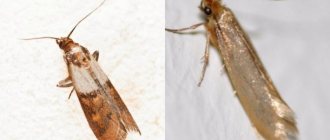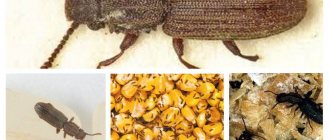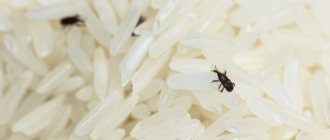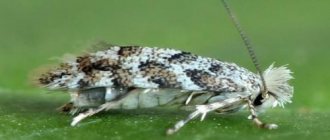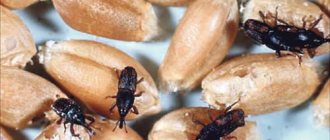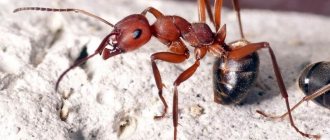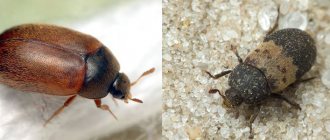/Order/
Moths in the kitchen are not only flying moths, but also their pupae, larvae and eggs.
- This means that in order to eliminate pests forever, you need to deal with them comprehensively - find and eliminate the source, clean the furniture/ceiling, throw away everything that was infected and process potentially infected products.
Food moths come in different types. Most often in the kitchen of a city apartment you can find: flour moth, a little less often - cocoa moth (very similar to clothes moth) and southern barn moth (fighting it is more difficult than others). Where do they come from even in the cleanest kitchen cabinets?
- Tiny, almost invisible eggs end up in the kitchen in packages of cereals, cereals, biscuits, dried fruits, flour, spices and other groceries. Then, within a week, they hatch into food moth larvae, which subsequently pupate and turn into moths.
In this material you will find step-by-step instructions on how to get rid of food moths, what preventive measures to take to avoid their reappearance, and how to save food if you don’t want to throw it away.
And a little more about prevention
The following tips will help you avoid the recurrence of moths:
- Try not to let food sit for more than 2-4 months and, of course, do not store supplies that have passed their expiration date.
- Store foods you rarely use in the refrigerator.
- Buy dry foods in small quantities so you can eat them within a couple of months.
- Buy groceries only from reputable manufacturers and, if possible, check the quality of the goods in the store. To be sure, freeze freshly purchased cereals, cereals, flour, nuts, dried fruits and other products for 3-4 days (in dry form).
- Animal food, such as bird seeds or fishing bait, should not be stored in the kitchen.
Support the project - share the material with your friends on social networks:
Reasons for appearance
Of course, the parasite does not appear out of nowhere. Where do moths come from?
The most common reason for the appearance is contaminated products brought from the store.
Most of the larvae are in bulk products: flour, cereals, dried fruits, nuts, herbs.
Therefore, if you want to avoid this problem, purchase such products from trusted stores and carefully check the tightness of the packaging.
Another source of infection is neighbors. If they have this problem, it is likely that some of the moths will move to you in search of a more varied diet.
Moths may fly into the window - however, this case is considered quite rare, so there is no need to worry.
How to get rid of eggs and larvae
If you want to get rid of moths forever, be prepared for a rather long and painstaking process. There are many methods.
You can choose special insecticides, or you can choose folk remedies - the main thing is to be consistent and not give up halfway.
Warning: We recommend that you do not use moth traps. Yes, they are quite effective and attract all adult parasites. However, there are many complaints on the Internet that, along with “house” moths, such a device also attracts “guests” from neighbors and from the street. Think about whether you need such a spontaneous increase in the moth population in your apartment.
Various chemical poisons work well: Raptor, Armor, Combat. They really do have their drawbacks. If they come into contact with food, they can seriously harm human health. Therefore, you need to handle furniture with extreme caution, and it is better not to touch storage containers at all.
It is not surprising that many people prefer folk remedies to fight moths.
However, any means of combating butterflies and larvae will be ineffective if you do not first eliminate the egg laying sites.
On the Internet you can find a recommendation to throw out absolutely all food from the kitchen - this will help make moths feel like the French near Moscow in 1812. But such measures are too radical - they should be taken only if the degree of infection is very high.
In other cases, it is enough to simply sort through the bulk products, removing eggs and larvae from them, and then freeze or heat in the microwave.
After this, you need to thoroughly wash the containers, treat them with vinegar and dry them well. This measure will not only remove traces of moth activity, but will also help repel it with a pungent odor.
Please note that larvae can be found almost everywhere. Be sure to go over the cabinets with a vacuum cleaner (not forgetting the outer parts), then treat them as well. The vacuum cleaner will suck up eggs that you haven't noticed.
Attention: Very often moths lay larvae not only in food, but also under the ceiling, where warm air rises during cooking. Therefore, we recommend going over the ceiling joints with special products or just apple cider vinegar. The same applies to chandeliers: if they have a lot of twisted parts that are not adjacent directly to the lamps, it is better to process them too.
We destroy pests
All cereals in which signs of infection were found must be disposed of. The correct thing to do would be to wrap the bulk products in a plastic bag and get rid of them immediately; you can throw them away, but it’s best to burn them.
Next you need to do a thorough cleaning. To do this, you need to remove all the contents of the cabinets, and, if possible, remove the shelves. We take a vacuum cleaner and carefully go through all the corners and crevices.
You need to use a small nozzle, there is no such thing, you can do without the nozzle. This will help collect all the larvae and pupae. But immediately after completing the procedure, you need to get rid of the contents of the bag.
It is advisable to vacuum all baseboards, tops of cabinets, ceilings, cracks near the chandelier, cracks near the cornices. Inspect the wallpaper, there may be places where they have fallen behind, there may be a nest there.
Afterwards, wet cleaning should be carried out, during which you can use chemicals or folk remedies. For example, you can wash cabinets and shelves with a vinegar solution or laundry soap.
There are special specialized preparations for cereal moths, for example, Raptor, Antimol. You will also need to thoroughly wash all jars and containers in which food supplies are stored with laundry soap or vinegar solution.
What harm does
The insect is not dangerous to humans. It does not bite and does not carry infections on its paws that threaten people. Kitchen moths do not eat clothes made from natural fabrics, so you don’t have to worry about the safety of your items.
Only food harms gray butterflies - a large number of food moth larvae feeding on food damages them irrevocably.
The materials become unsuitable for consumption or further processing. All you can do is get rid of spoiled grains or nuts as soon as possible to prevent contamination of other foods.
Description of the insect
The butterfly of the cereal (kitchen, grocery) moth has a gray-yellow or gray-brown color with a dark spotted pattern. The maximum length of the body is 1 centimeter, the wingspan is 1-1.6 centimeters. The insect flies slowly and chaotically, so it is easy to swat it with your hands.
The butterfly's mouthparts are not developed and it does not feed. Life expectancy is 5-7 days. In such a short period of time, the butterfly manages to lay 100-160 eggs. For successful reproduction, pests need warm temperatures (23-27 degrees), humidity of 50% and access to bulk products.
Fresh kitchen moth eggs are 0.5 millimeters long and white in color; later they turn yellow. After 1-2 weeks, larvae appear - the main culprits in the spoilage of cereals.
The body length of caterpillars varies between 0.3-1.5 centimeters. These are thin white worms with an orange dot on their head.
Kitchen moth larvae live and feed for 1-2 months, and then look for shelter (a crack in a cabinet, the bottom of a jar) to weave a cocoon and turn into a butterfly. The pupation process takes 2 weeks.
Saving food: measures to combat larvae
As we already said, the most effective way to kill the larvae is to throw away all the food. However, if you do not agree to such sacrifices, then it is necessary to secure the remaining supplies.
You can do this in several ways:
- Hand-sort the grains and sift the flour and salt through a sieve.
- Place the food in the freezer for at least three to four days.
- An alternative way is to bake the food in the oven at 60 degrees for 40 minutes. However, this method is not suitable for all types of groceries. For example, the flour will darken or spoil. Semolina will also lose its quality, so this method is recommended only for whole grain cereals.
- If you have a microwave, pour the cereal into a bowl and microwave for 2-3 minutes at maximum power. Like the previous method, this one is only suitable for whole grain cereals.
These methods are very effective, but require careful preliminary mechanical processing of cereals and other products. You need to pick out all the larvae and eggs, otherwise they will remain in the food, even if frozen or baked.
All inventory must be checked manually
In our opinion, not the most appetizing seasoning. Therefore, we advise you to throw away your groceries anyway - cereals, pasta and flour are not that expensive, and the larvae, even if thermally processed, can cause an allergic attack.
Signs of kitchen moth infestation
Having figured out how moths appear in the kitchen, we move on to the next stage - getting rid of them. It is important to understand that the sooner you begin the process of “treating” the kitchen from food moths, the less effort you will have to put in.
Carefully examine all the cereals you bring - there may be an uninvited guest in them
By these signs you can determine that the room is already infested with parasites:
- The most obvious sign is adults. If you see at least one butterfly, we recommend that you immediately attend to the issue of eliminating parasites.
- Musty smell on food shelves. Dead larvae and waste products decompose and emit an unpleasant, subtle aroma.
- The presence of cobwebs, darkish or gray cocoons in cereals and grains. This means that the product has already become a nesting ground for larvae.
- The most unpleasant sign of infection is the presence of yellow worms and moth larvae. They can crawl around in food or crawl along the walls of the cabinet.
If you are not sure whether you have moths in your kitchen, use our life hack. Turn on a small flashlight in the kitchen at night and wait five to ten minutes. Adult butterflies always flock to the light.
If you encounter such phenomena, you must urgently begin to eliminate the parasites!
Preventive measures
When replenishing your food supply, it is important to remember some preventive measures:
- Be careful when purchasing groceries at low prices, checking the expiration date and condition of the packaging.
- Before storing, treat with cold or high temperature.
- Store all products in airtight containers.
- Use moth repellents.
- Do not stock up on large amounts of food.
- Monitor the condition of kitchen cabinets, wash and ventilate them regularly.
- Conduct an inspection of existing inventory.
Following preventative practices will help preserve food.
Varieties of moths
There are several types of home moth; each group gives preference to its favorite product, but does not neglect others. There are eight main types of household pests.
- Flour moth. The firefly is small in size with beige colored wings. This type of insect reproduces faster than its counterparts. If you notice small cocoons in the flour, it means that the parasite has entered the house. Sift the flour through a sieve, then cook in the oven for at least half an hour. Store flour in an airtight container.
- Grain moth. A firefly with narrow wings of a yellowish tint, the color is similar to the color of grain so that it can blend in with it. She focuses on buckwheat, rice, rye and wheat. The safest way to get rid of the parasite is to use special traps.
- Mill moth. A butterfly up to 1.5 cm in size, with dark gray dotted wings. This type of moth is rarely found in apartments; they are usually found in mills.
- Potato moth. A small, inconspicuous moth with gray wings and long antennae. The larvae like to attack old potatoes, as their tubers are softer. They bite into fruits, causing rotting. You can fight potato moth by adjusting the storage temperature of root crops below 0°C. For a better effect, tubers can be treated with biological preparations.
- Onion moth. Wingspan up to 17 mm. The body and fore wings are brown, the hind wings are gray with fringe. The larvae eat the onion, causing the vegetable to rot.
- Cereal moth. A butterfly with silver-gray wings, the span of which reaches 14 mm. The larva destroys cereals and seeds, gluing the grains into pellets using a web. Its appearance indicates that the grain has already been stored in the warehouse.
- Chocolate moth. Eats coffee, cocoa beans, chocolate and other “confectionery”. She makes passages in chocolate products, leaving behind grains of feces. The size of the worms does not exceed 0.5 cm, so they fit into the smallest holes in the wrapper.
- Fruit moth. The gray butterfly, approximately 10 mm in size, is nocturnal. Moths grow in dried fruits, fruits and mushrooms. Its larvae break through canals, turning the fruits into dust. The insect does not disdain other products, so you can see moths in walnuts, almonds or hazelnuts.
In the apartment, food moths eat all grocery products. Therefore, first check for caterpillars:
- cereals;
- pasta;
- beans;
- peas;
- flour;
- sugar;
- candies;
- nuts and dried fruits;
- bread;
- cookie;
- spices;
- tea;
- coffee;
- cocoa;
- animal feed.
Different types of parasites can easily live next to each other. Therefore, when you find a moth, carefully check not only your food, but also your wardrobe.
Routes of penetration
Many housewives are puzzled by the question of why moths appear in cereals. Moths can get into the house in several ways:
- With contaminated products from a market or store;
- Through a window in the absence of a mosquito net;
- Through the vent.
To minimize the risk of pest butterflies entering your apartment, it is preferable to purchase groceries in large stores rather than at street markets. It is incorrect storage conditions that contribute to the spread of the pest.
Can I use chemicals?
Household chemical stores sell aerosols, sprays, and fumigators against moths. However, these products contain insecticides (permethrin, tetramethrin, diazinon, piperonyl butoxide) - highly toxic substances.
If you treat kitchen cabinets with chemicals, the poisons will get onto the food and lead to food poisoning. Therefore, it is better not to take risks and get rid of moths in cereals in other ways.
There is only one useful remedy against kitchen pests, which is sold in the store. It will be discussed below.
Kinds
Depending on certain food preferences, as well as the characteristics of localization, life activity, and color, food moths are divided into several main subspecies, the main ones of which are the following:
- Flour moth or moth. This is the most unpretentious type of insect, common in ordinary apartments.
- Kitchen moth or cocoa moth. This species is especially often confused with the clothes one, which is due to the specific coloring - the wings of such insects have a light yellow tint.
- Fruit moth. As the name suggests, the larvae of this insect prefer to eat dried fruits and fresh fruits. This butterfly is also a garden pest.
- Barn fire. This insect is often found in large granaries. It is especially difficult to destroy.
All types of food moths share food preferences, namely: their food sources are groceries, flour, sugar, cookies, dried bread, and more.


